Brazil is a very diverse country regarding honey production, which is only possible throughout the year due to its floristic richness resulted from its extensive territory and climate variability (Melo 2008). With a total of 35,704 native species of flowering plants, the country comprises the most remarkable diversity of plants worldwide, with a high rate of endemism (Flora do Brasil 2020).
This scenario makes Brazil, and especially the Northeast Region of the country, a place with high melliferous potential. This was evidenced in 2017, when the region stood out with 30.7 % of national honey production (IBGE 2017). Besides, honey produced in Northeast Brazil is considered an organic bee product due to low contamination by pesticides and antibiotic residues - as it comes from native vegetation, and the low humidity of the air makes it difficult for diseases to affect bees, dispensing the use of medicine - and its unique botanical origin, thanks to the extensive number of endemic flora in the Caatinga Biome, which comprises 47 % of the region. (Oliveira & Santos 2014, Vidal 2019). Although, despite its biological relevance, the Caatinga is the Brazilian biome most subject to anthropization processes, such as desertification, jeopardizing its vast biodiversity (Leal et al. 2003).
Regional floristic studies are still needed within the Caatinga biome to expand the information on its vegetation, which is a fundamental part of the diet and survival of bees. Characterizing pollen grains from this flora is the next step in recognizing pollen types found in Caatinga’s bee products, indicating its botanic origin and adding value to the final product (Barth 1989, Aguiar et al. 2002, Giulietti et al. 2005, Oliveira & Santos 2014).
The relationship between plants and their pollinators has evolved throughout geological time, with flower resources, such as nectar and pollen, being offered by plants. On the other hand, pollinators transport microgametophytes between individuals, ensuring the reproductive success, genetic diversity, and geographic distribution of flowering plants (Stelleman 1984, Raven et al. 1996, Lunau 2000, Fluri et al. 2001, Sekine et al. 2013, Pinheiro et al. 2014). Not only are floral rewards responsible for attracting pollinators, but also the chemical, enzymatic, and morphological composition of its pollen grain walls play a role in the attraction and their fixation on pollinators (Payne 1981, Stelleman 1984, Hesse 2000, Vaknin et al. 2000). Here we highlight the pollen characters that may favor pollination, i.e., dispersion units, size, shape and exine ornamentation, representing a strategy developed by plants to ensure its successive reproduction.
Thus, this study aimed to characterize the bee flora and its pollen morphology in an area of the Caatinga in Northeast Brazil, highlighting pollen attributes that may favor pollination.
Materials and methods
Sampling area. Samples were collected in a Caatinga area surrounding the Quicé district’s apiary (10º 55’ S, 40° 03’ W) located 17 kilometers from the municipality of Senhor do Bonfim, State of Bahia, Northeast Brazil (Figure 1). The climate is classified as BSh semiarid warm according to Köppen (Alvares et al. 2013), with high temperatures, rainy summer and dry winter. Climatic data were obtained for the collection period (August/2016 to June/2017) from the Instituto Nacional de Meteorologia (INMET). Median annual temperatures varied from 22-27 °C and median rainfall was 207 mm in the municipality of Senhor do Bonfim.
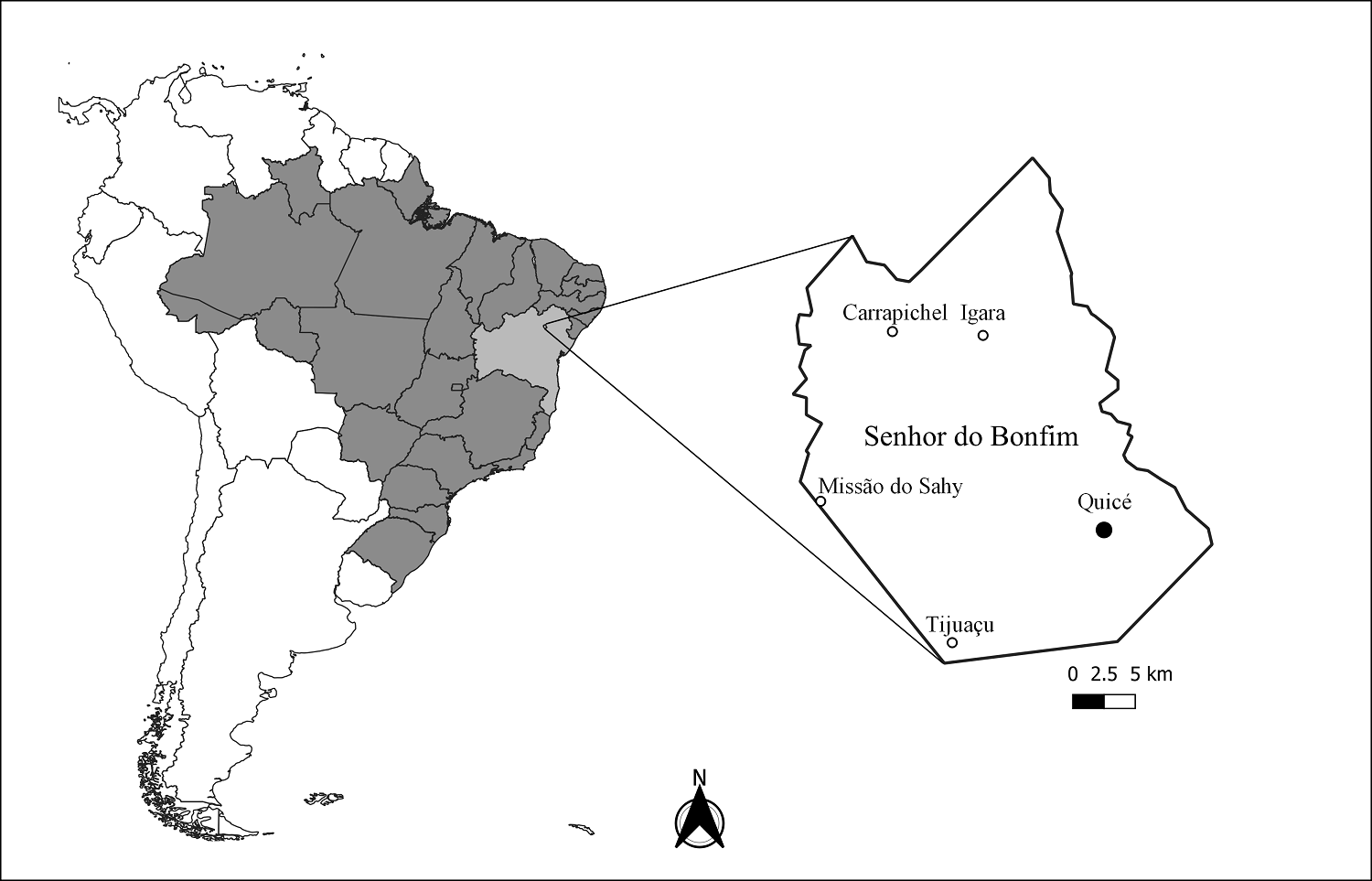
Figure 1 Location of Quicé’s District (black point) and other districts (blank point) of Senhor do Bonfim, Bahia State, Northeast Brazil.
Sampling collection. Biweekly collections were performed from August 2016 to June 2017 in the study area. The apiary was regarded as the central point to walks distancing up to 1,000 meters surrounding this site, collecting up to five branches of all flowering plants, and observing if the individuals were being visited and having its floral resources collected by Apis mellifera L. (1758) individuals. Plant materials were herborized and posteriorly identified using specialized literature, taxonomic keys, and comparing with specimens deposited at the HUNEB (Universidade do Estado da Bahia, Campus Senhor do Bonfim) and HUEFS (Universidade Estadual de Feira de Santana) herbaria, besides the help of taxonomists. For the characterization of the bee flora, we considered plants that were visited by bees to collect resources (nectar, pollen, resin or oil), and we cross-referenced the obtained data with the specialized literature, which also indicates the type of floral resource provided by the plants (Table S1). To determine the endemic taxa, the Flora do Brasil (2020) was consulted online at floradobrasil.jbrj.gov.br/
Laboratory sample processing. Pollen samples were processed at Laboratório de Estudos Palinológicos (LAEP) from the Universidade do Estado da Bahia (UNEB - Campus Senhor do Bonfim). Pollen grains were prepared using acetolysis (Erdtman 1960) and posteriorly mounted within slides and coverslips embedded in glycerinated jelly and sealed with paraffin. Permanent slides were deposited in the pollen collection of LAEP.
Pollen description. Pollen grains were analyzed under light microscopy and photomicrographed using a Zeiss Axiostar Plus® photomicroscope. The morphological description of pollen grains was elaborated based on size, shape, ambitus, dispersion unit, aperture type, and exine structure and sculpture. Measurements of the equatorial diameter and polar axis were randomly taken in 25 pollen grains for each species and ten measurements were taken for apertures, exine, and sexine elements. Pollen nomenclature was based on Punt et al. (2007). Measurement data were plotted on a spreadsheet and statistically analyzed using the Excel software for the obtention of the arithmetic average, sample standard deviation, mean standard deviation, coefficient of variability, and confidence interval at 95 %, and the variation range of pollen parameters with sample size equal to 25. For the remaining measurements of 10 sample units, only the arithmetic average was calculated.
Results
A total of 57 species of flowering plants were collected in bloom, from which 45 were recognized as species that provide resources to bees, based on field observation of A. mellifera foraging activity as well as information from specialized literature (Table S1). The plant species that compose the bee pasture comprised 41 genera and 23 families of flowering plants. The following families stood out in species number: Fabaceae (eight spp.), Euphorbiaceae (seven spp.), Asteraceae (four spp.), and Malvaceae (four spp.). The data reveal 51 % of shrubby to subshrubby species, 38 % herbaceous, and 11 % tree species.
From the 45 beekeeping relevant species identified in this study, 17 are endemic to Brazil, and eight species are restricted to the Caatinga biome: Isocarpha megacephala Mattf. (Asteraceae), Varronia leucocephala (Moric.) J.S.Mill. (Boraginaceae), Colicodendron yco Mart. (Capparaceae), Cnidoscolus obtusifolius Pohl ex Baill. (Euphorbiaceae), Cenostigma nordestinum Gagnon & G.P.Lewis, Mimosa arenosa (Willd.) Poir., Peltogyne pauciflora Benth. (Fabaceae), and Sida galheirensis Ulbr. (Malvaceae) (Figure 2).
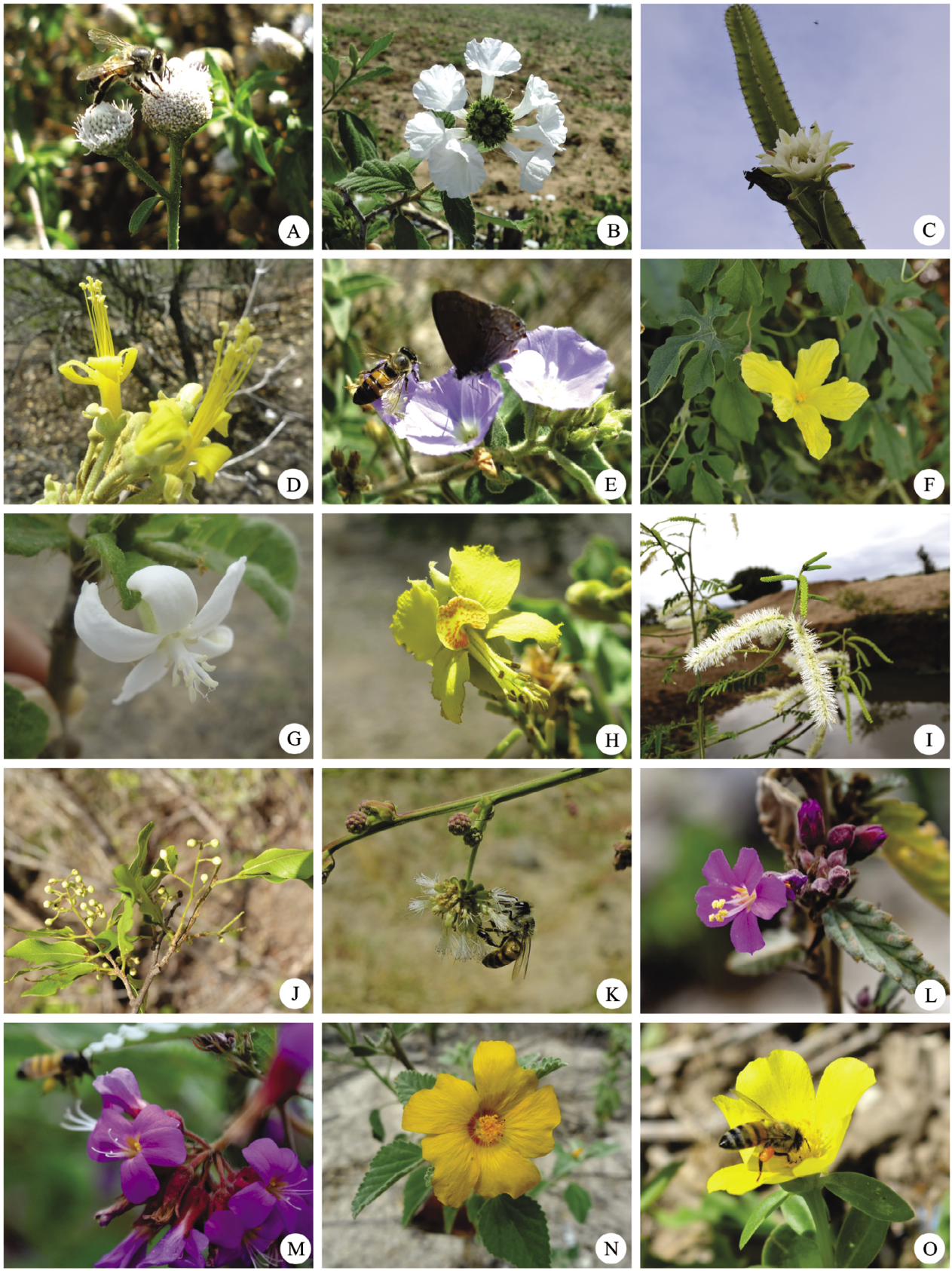
Figure 2 Botanical species considered important for the diet of Apis mellifera in a Caatinga area of Northeast Brazil. A. Isocarpha megacephala Mattf.* B. Varronia leucocephala (Moric.) J.S.Mill.* C. Cereus jamacaru DC. D. Colicodendron yco Mart.* E. Jacquemontia multiflora (Choisy) Hallier f. F. Momordica charantia L. G. Cnidoscolus obtusifolius Pohl ex Baill. Kunth.* H. Cenostigma nordestinum Gagnon & G.P.Lewis. I. Mimosa arenosa (Willd.) Poir.* J. Peltogyne pauciflora Benth.* K. Senegalia bahiensis (Benth.) Seigler and Ebinger. L. Melochia tomentosa L. (short-styled morph). M. M. tomentosa L. (long-styled morph). N. Sida galheirensis Ulbr.* O. Portulaca umbraticola Kunth. * = Endemic species of the Caatinga.
A different group of plant species was regarded as essential to the diet and survival of Apis mellifera bees due to the frequency of visits recorded during field observations: Cereus jamacaru DC. (Cactaceae), Colicodendron yco, Jacquemontia multiflora (Choisy) Hallier f. (Convolvulaceae), Momordica charantia L. (Cucurbitaceae), Cenostigma nordestinum, Senegalia bahiensis (Benth.) Seigler & Ebinger (Fabaceae), Melochia tomentosa L. (Malvaceae), and Portulaca umbraticola Kunth (Portulacaceae) (Figure 2).
Pollen description. Pollen morphology data obtained in this study were highly varied, according to the diversity of analyzed species. Thus, they are presented below within each pollen parameter analyzed. Plant data and morphological descriptions of pollen grains are shown in Table S1, while morphometric data of isopolar and apolar/heteropolar pollen grains are presented in Tables S2 and S3, respectively. Pollen photomicrographs are shown in Figures 3-5.
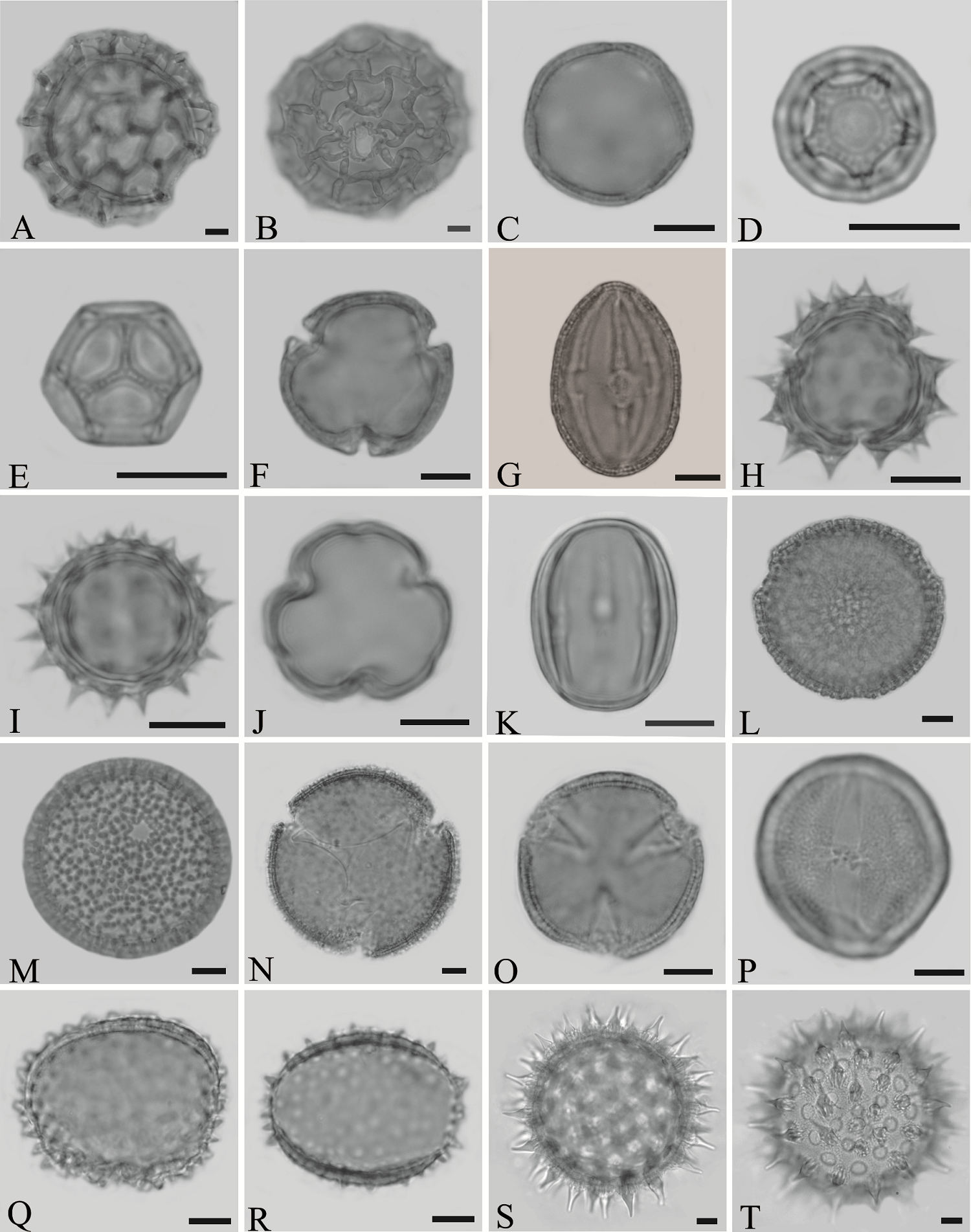
Figure 3 Pollen grains of bee flora from a Caatinga area of Northeast Brazil. A-B. Ruellia paniculata (Acanthaceae). C. Echinodorus subalatus (Alismataceae). D-E. Alternanthera brasiliana (Amaranthaceae). F-G. Spondias tuberosa (Anacardiaceae). H-I. Acanthospermum hispidum (Asteraceae). J-K. Euploca procumbens (Boraginaceae). L-M. Varronia leucocephala (Boraginaceae). N. Cereus jamacaru (Cactaceae). O-P. Colicodendron yco (Capparaceae). Q-R. Commelina erecta (Commelinaceae). S-T. Ipomoea incarnata (Convolvulaceae). Scales = 10 µm.
Dispersal unit, polarity and ambitus. Most pollen grains are dispersed in monads, less frequently in ditetrads (Mimosa arenosa (Willd.) Poir. (Figure 4O)) and polyads (Senegalia bahiensis (Benth.) Seigler & Ebinger (Figure 4P)). Among the studied species, 24 are characterized by isopolar pollen grains, 19 by apolar pollen grains, and only Commelina erecta L. (Commelinaceae) and Pontederia paniculata Spreng. (Pontederiaceae) pollen grains were described as heteropolar (Figures 3Q-R, 5N, respectively).
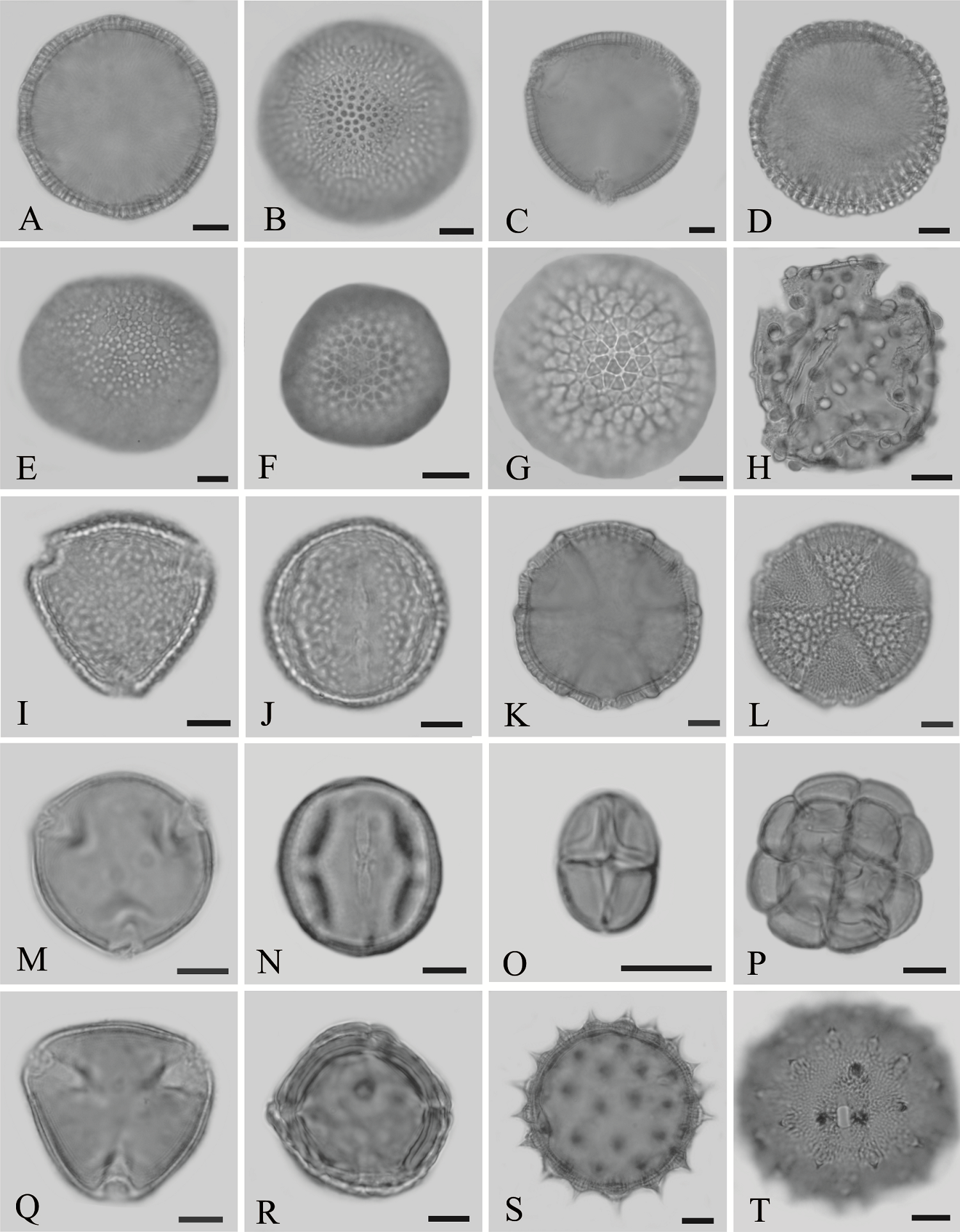
Figure 4 Pollen grains of bee flora from a Caatinga area of Northeast Brazil. A-B. Jacquemontia multiflora (Convolvulaceae). C. Momordica charantia (Cucurbitaceae). D-E. Cnidoscolus obtusifolius (Euphorbiaceae). F. Croton heliotropiifolius (Euphorbiaceae). G. Jatropha ribifolia (Euphorbiaceae). H. Bauhinia affinis (Fabaceae). I-J. Cajanus cajan (Fabaceae). K-L. Cenostigma nordestinum (Fabaceae). M-N. Macroptilium bracteatum (Fabaceae). O. Mimosa arenosa (Fabaceae). P. Senegalia bahiensis (Fabaceae). Q. Senna uniflora (Fabaceae). R. Heteropterys trichanthera (Malpighiaceae). S-T. Herissantia crispa (Malvaceae). Scales = 10 µm.
The ambitus showed five patterns: circular or subcircular in 60 % of pollen grains, such as in pollen grains of Herissantia crispa (L.) Brizicky (Malvaceae, Figure 4S-T); subtriangular in Acanthospermum hispidum DC. (Asteraceae, Figure 3H-I); triangular in Senna uniflora (Mill.) H.S.Irwin & Barneby. (Fabaceae, Figure 4Q); and ellipsoidal in Commelina erecta.
Dimensions and shape. The size of analyzed pollen grains varied from small - with the smallest diameter in Amaranthaceae: Alternanthera brasiliana (L.) Kuntze (Figure 3D-E) , to large - with the largest diameters recorded in Acanthaceae: Ruellia paniculata L. (Figure 3A-B) (Table S2). The spherical shape was the most representative within the studied species (Table S1), such as in Ipomoea incarnata (Vahl) Choisy (Convolvulaceae, Figure 3S-T). Oblate-spheroidal pollen grains were recorded in Varronia leucocephala (Moric.) J.S.Mill. (Boraginaceae, Figure 3L-M), and subprolate in Euploca procumbens (Mill.) Diane & Hilger (Boraginaceae, Figure 3J-K). The prolate, prolate-spheroidal, suboblate and oblate shapes were recorded on pollen grains of Bauhinia affinis Vogel. (Figure 4H), Cajanus cajan (L.) Huth. (Figure 4I-J), Cenostigma nordestinum Gagnon & G.P. Lewis (Figure 4K-L) from Fabaceae and Pontederia paniculata (Pontederiaceae), respectively.
Apertures. Simple apertures were recorded in 16 species, while composed apertures were recorded in 23 species. Porate pollen grains were recorded in Sida galheirensis (Figure 5E-F), colpate pollen grains in Cereus jamacaru L. (Cactaceae, Figure 3N), and colporate pollen grains in Macroptilium bracteatum (Nees & Mart.) Maréchal & Baudet (Fabaceae, Figure 4M-N). As for the number of apertures, 3-colporate pollen grains were predominant in 18 species, such as Peltogyne pauciflora (Fabaceae). The number of apertures was quite variable among the studied species, varying from 3-4-5-6-7-8-poli-aperturate. About position, pollen grains with apertures distributed in the equatorial zone (zonoaperturate) were predominant, besides pantoaperturate pollen grains with apertures distributed all over the exine’s surface, commonly found in porate pollen grains. Variations on type, number and position of apertures might be due to the variety found in the botanical families studied.
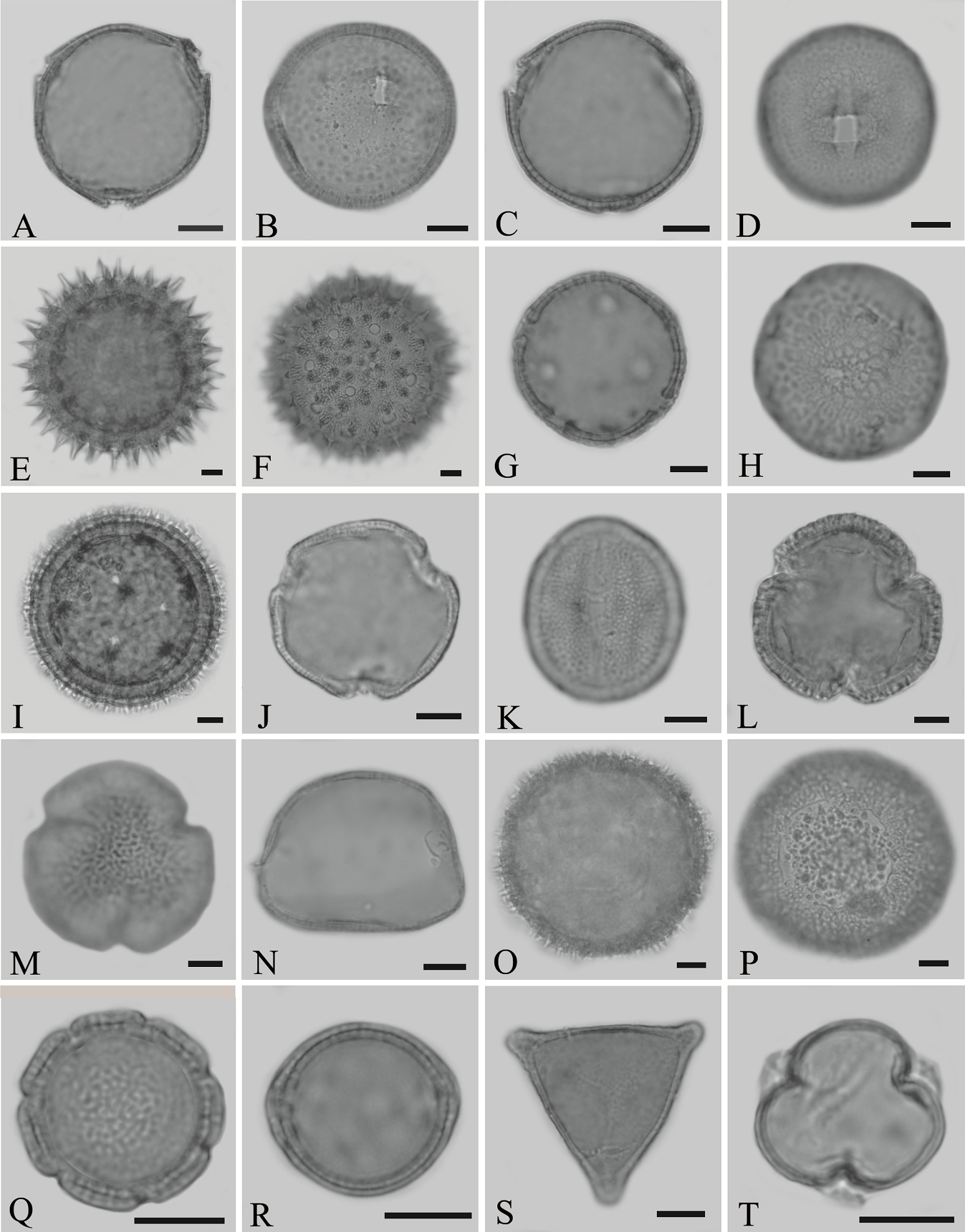
Figure 5 Pollen grains of bee flora from a Caatinga area of Northeast Brazil. A-B. Melochia tomentosa (short-styled morph) (Malvaceae). C-D. Melochia tomentosa (long-styled morph) (Malvaceae). E-F. Sida galheirensis (Malvaceae). G-H. Waltheria indica (Malvaceae). I. Boerhavia diffusa (Nyctaginaceae). J-K. Oxalis psoraleoides (Oxalidaceae). L-M. Turnera pumilea (Passifloraceae). N. Pontederia paniculata (Pontederiaceae). O-P. Portulaca umbraticola (Portulacaceae). Q-R. Borreria verticillata (Rubiaceae). S. Cardiospermum corindum (Sapindaceae). T. Solanum gardneri (Solanaceae). Scales = 10 µm.
Exine ornamentation. The exine from the studied species was greatly ornamented, being psilate on pollen grains of Mimosa arenosa and Solanum gardneri Sendtn., besides 11 different ornamentation patterns found on the remaining species (Table S1), such as:
(I) Exine with a single ornamentation pattern: microreticulate to reticulate in pollen grains of 22 species, such as in Colicodendron yco (Figure 3O-P) and Melochia tomentosa L. (lon-styled morph, Figure 5C-D); Croton pattern found in pollen grains of seven species of Euphorbiaceae; rugulate in pollen grains of Echinodorus subalatus (Mart.) Griseb (Figure 3C); microverrucate in pollen grains of Pontederia paniculata (Figure 5N); and areolate in Senegalia bahiensis (Figure 4P).
(II) Exine with more than a single ornamentation pattern: echinate-granulate on pollen grains of Ipomoea incarnata Choisy (Figure 3S-T); (micro)echinate-perforate in Cereus jamacaru DC. (Figure 3N); echinate-microreticulate on pollen grains of Sida galheirensis Ulbr. (Figure 5E-F); microreticulate-rugulate on pollen grains of Borreria verticillata (L.) G.Mey. (Figure 5Q-R); gemmate-microreticulate in Bauhinia affinis Vogel (Figure 4H); and striate-reticulate on pollen grains of Spondias tuberosa Arruda.
Discussion
Bee flora. The survey of 45 resource-providing species for Apis mellifera in an area of Caatinga in the State of Bahia and their pollen characterization showed that the bee flora in the studied area comprises several endemic species from this biome, such as Isocarpha megacephala, Varronia leucocephala, Colicodendron yco, Cnidoscolus obtusifolius, Cenostigma nordestinum, Mimosa arenosa, Peltogyne pauciflora, and Sida galheirensis. The occurrence of these species was also recorded by other Caatinga flora’s authors (Aguiar et al. 2002, Aguiar 2003, Pereira et al. 2004, Santos et al. 2006, Maia-Silva et al. 2012, Silva et al. 2016).
Fabaceae (eight spp.), Euphorbiaceae (seven spp.), Asteraceae (four spp.), and Malvaceae (four spp.) were the most diverse families in this study. These same families were highlighted for Caatinga areas from the State of Piauí (Silva et al. 2014) and Sergipe (Machado et al. 2012). Studies in the State of Bahia recorded Fabaceae, Malvaceae, and Euphorbiaceae as the richest families (Carvalho & Marchini 1999, Aguiar et al. 2002, Rodarte et al. 2008, Silva et al. 2016), corroborating the data presented in this study. Studies from Dórea (2007), Lima (2007) and Costa et al. (2015) highlight the importance of the Fabaceae family in the plant composition of the Caatinga biome for Apis mellifera, being also the richest family in this study. The richest genus was Croton (Euphorbiaceae) with four species (C. argyrophyllus, C. echioides, C. heliotropiifolius, and C. lundianus). Similar data were found by Machado et al. (2012) for Croton.
An elevated rate of nectar-providing plants was recorded, with 51 % of nectar-providing species and 40 % of nectar and pollen-providing species, besides a small occurrence of oil and resin-providing plants. Data from this study corroborate the results found in the specialized literature for studies in areas of Caatinga in the State of Pernambuco, and also in other Brazilian ecosystems (Machado & Lopes 2004, Silberbauer-Gottsberger & Gottsberger 1988, Oliveira & Gibbs 2000) since they highlight a high rate of plant species pollinated by nectar-feeding insects. According to Simpson & Neff (1981, 1983), floral resources stimulate constant visitation on flowers, leading to pollination, in which nectar is the most important floral reward due to being metabolically low-cost and easily digested by animals. Pollen grains are not regarded as satisfactory energy sources for animals, such as bees, since these insects show high energetic demand. Although pollen grains represent a high-quality energy source, their digestion process is very slow due to the almost indestructible exine (McLellan 1977). In this study, the botanical families most visited for pollen resources were Asteraceae, Convolvulaceae, Cucurbitaceae, Euphorbiaceae, Fabaceae, Malvaceae, and Portulacaceae. These same families were also to be representative in the studies of Aguiar (2003), Machado et al. (2012), and Maia-Silva et al. (2012).
In the present work, we highlight the beekeeping importance of Melochia tomentosa due to being flowering all year long (including during the dry season) and by the constant visitation of bees on its flowers, being regarded as one of the most important species in the diet and survival of Apis mellifera bees in the Caatinga biome (Aguiar et al. 2002, Aguiar 2003, Machado & Sazima 2008, Silva et al. 2014).
Pollen morphology regarding pollination process. In this study, we aim to characterize the morphology of pollen, and also try to associate the pollen characters to the pollination process, as suggested in the works of Wodehouse (1935), Corbet et al. (1982), Dafni et al. (2000), Clarke et al. (2017), and Vaknin et al. (2000). These authors theorize an association between pollen types and the electrification effect or the adhesion of exine structures to the bee’s body. Among the palynological attributes, polarity and aperture type don’t seem to play a role in the pollination process, according to Rasoloarijao et al. (2019).
Most pollen grains in this study are dispersed as monads (96 %), with only two species dispersed in ditetrads and polyads (Mimosa arenosa and Senegalia bahiensis). Studies developed by Pacini & Franchi (1999) and Timerman et al. (2014) assume that anemophilous species tend to disperse solitary monads, while zoophilous species are more likely to disperse aggregate pollen. However, the authors pointed that the quantity of pollenkitt and the presence of sexine elements may contribute with the adhesion of the pollen grain to the body of the pollinator. Accordingly, among the 43 pollen types dispersed in monads in this study, 41 show sculptural elements facilitating an entomophily tendency (Wodehouse 1935). The studied pollen grains dispersed in monads were found in families such as Asteraceae, Convolvulaceae, Cucurbitaceae, and Nyctaginaceae. Data for dispersion units among the studied species corroborate data from the specialized literature (Perveen & Qaiser 2008, Vasconcelos et al. 2015, Silva et al. 2016, Wolff et al. 2016).
Regarding polarity, most studied pollen grains were isopolar (53 %), followed by apolar (42 %), and only two species were heteropolar. There is not enough information in literature that correlates polarity to pollination.
Pollen grains from the studied species showed sizes from small (14.2 µm) to large (86.5 µm), with 38 species showing medium to large pollen grains and seven species showing small pollen grains. From an ecological point of view, Lu et al. (2021) reveal that anemophilous pollen grains are smaller than those from entomophilous plants, that present mostly medium to large sizes, corroborating the data obtained in this study. Among the families in this study with pollen grains of medium to large-sized, Anacardiaceae, Boraginaceae, Cactaceae, and Passifloraceae are highlighted. The results obtained for pollen grain size corroborate the descriptions of Santos et al. (1997), Gasparino & Cruz-Barros (2009), Matos et al. (2014), Pereira et al. (2014), and Assis et al. (2021).
The spheroidal shape was the most frequent among pollen grains from the studied species in families, such as Acanthaceae, Amaranthaceae, Euphorbiaceae, and Portulacaceae. Other shape classes were also described, such as oblate-spheroidal (Asteraceae), oblate (Pontederiaceae), subprolate (Cactaceae), prolate (Fabaceae), prolate-spheroidal (Capparaceae), and suboblate (Fabaceae). Palynological characters from the studied pollen grains corroborate the descriptions of Cruz-Barros (1994), Corrêa (2003), Buril et al. (2011), Sánchez-del Pino et al. (2016), Santos (2016), Silva et al. (2016), and Souza et al. (2016). Lu et al. (2021), concluded that pollen grains of entomophilous species tend to be oblate, with oblate, oblate spheroidal and prolate forms standing out, similar data was obtained in the present study.
Within the studied pollen grains, 82 % of families showed three or more apertures (i.e., colpus, porus or colporus), such as Cactaceae and Portulacaceae (colpate pollen grains), Alismataceae, Malvaceae, and Nyctaginaceae (porate pollen grains), and Anacardiaceae and Fabaceae (colporate pollen grains). The pollen characterization of studied species corroborates the studies of Buril et al. (2011), Pereira et al. (2014), Radaeski et al. (2014), Saba & Santos (2015), Silveira Júnior et al. (2015, 2017) and Silva et al. (2016). Two monocot species showed sulcate pollen grains (Commelina erecta and Pontederia paniculata), and six species of Euphorbiaceae, belonging to Croton and Jatropha, showed inaperturate pollen grains, their pollen description are in accordance with previous studies developed by Rowley (1959), Ybert et al. (2017) and Souza et al. (2016).
In this study, pollen grains are richly ornamented, except for Mimosa arenosa (Willd.) Poir. and Solanum gardneri Sendtn., which showed psilate surface. However, these species are highlighted by respectively offering notable amounts of nectar and pollen to their pollinators (Bezerra & Machado 2003, Maia-Silva et al. 2012, Tabatinga Filho 2013). Regarding exine sculpture, some authors, such as Hesse (2000) and Vaknin et al. (2000), suggest that pollen grain exine plays a role in pollination, since sexine elements adhere to animal’s body and allow their transport to the stigmatic surface of another flower (Walker & Doyle 1975, Payne 1981, Stelleman 1984). Manso Manso & Mateu Andres (1993), correlated the exine thickness and ornamentation to the pollination process, indicating that several variations in exine sculpture result from selective pressures jointly acting with pollination mechanisms (Ferguson & Skvarla1982, Osborn et al. 1991, Tanaka et al. 2004). Thus, besides allowing pollen grain aggregation, they facilitate their transfer and adhesion to the floral visitor’s body. Researchers, such as Vaknin et al. (2000), Clarke et al. (2013) and Greggers et al. (2013) believe that patterns of exine ornamentation are subject to electrostatic forces, which not only constitute an adhesion factor of pollen grains to the pollinator’s body, due to different electric charges, but might point bees to a determined plant by the perception of its electric field. Clarke et al. (2017) evidenced an interaction between flowers, bees, and the electric field, demonstrating that pollen grains behave in a non-random and organized way under the effect of electrostatic forces from the anthers to the pollinator’s body. However, ornamentation patterns that might facilitate this electroreception have not been studied yet, and as postulated by Mander et al. (2020), for each link between pollen morphology and pollination ecology, there is a counter example, making it difficult to stablish a pattern without further research (Simpson & Neff 1983).
At present, there is no published information that proves the role of morphological characters of pollen grains to the pollination process, although it is proven by Nicholls & Hempel de Ibarra (2017) that pollen characteristics as chemical composition, color and/or mechanosensory quality attract bees and leads visit on flowers. Nonetheless, additional studies are needed to elucidate the pollination ecology and possible interactions between ornamentation patterns and mechanisms of pollen grain transfer to the pollinator’s body.
In the study area, Apis mellifera bees use several plant sources in the Caatinga flora. Morphological characterizations of species visited by these bees showed that most pollen grains are dispersed in monads, are small- to large-sized, are mostly 3-aperturate, with colporate, porate or colpate apertures. The exine of pollen grains was greatly ornamented in different patterns, which might be associated with pollination mechanisms and plant coevolution. All pollen grains showed at least a single character that may facilitate entomophilous pollination. This study described the pollen grains of nine plant species for the first time, and it is the first one about bee flora characterization and pollen morphology to be carried out in the region and may support several future studies.
Supplementary material
Supplemental data for this article can be accessed here: https://doi.org/10.17129/botsci.2977











 nova página do texto(beta)
nova página do texto(beta)



